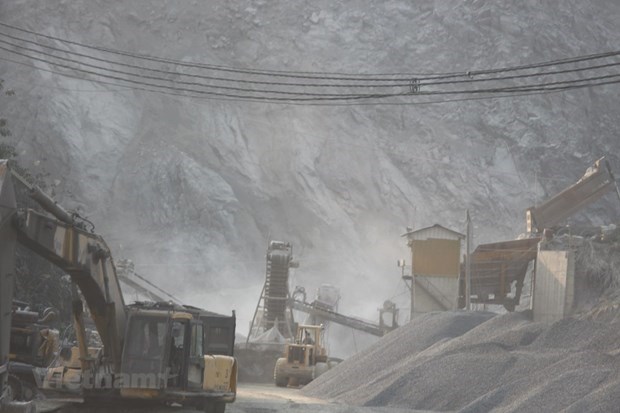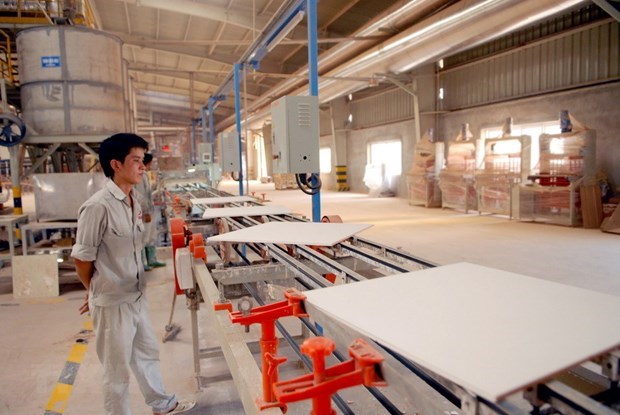Efforts made to modernise clinker production technology, halt natural sand exports
 At an unbaked building materials manufacturing plant of Dai Hong Son company in the southern province of Ba Ria-Vung Tau (Photo: VNA)
At an unbaked building materials manufacturing plant of Dai Hong Son company in the southern province of Ba Ria-Vung Tau (Photo: VNA)
Hanoi (VNA) – Deputy Prime Minister Trinh Dinh Dung has signed a decision approving a strategy on the development of Vietnam’s building materials for the 2021-30, with a vision to 2050.
The decision will take effect from the start of next year.
The strategy requires that cement factories producing less than 2,500 tonnes of cement clinker per day need to invest in modernising production technology. For the 2021-30 period, exports of building natural sand will be halted towards stronger investment in silica sand and minimising the use of natural sand in the construction sector.
Saving energy and protecting the environment
The overall objective of the strategy is to lift the building material manufacturing sector on a par with international standards, switch to energy-saving technologies so that products are competitive on both the foreign market and domestic market.
The strategy also looks to put an end to outdated building material production technology, increase export of value-added products and on the contrary reduce shipments of those made from non-renewable natural resources.
Another target is to only invest in factories with a capacity of 5,000 tonnes of clinker a day or more with electricity generation systems making use of emission heat.
All cement factories producing less than 2,500 tonnes of cement clinker per day must invest in electricity generation systems making use of emission heat and use fly ash or other industrial waste for at least 20 percent of materials for clinker or cement production. The ratio of clinker use in cement production of the whole sector is set at 65 percent at maximum.
Total yearly capacity of cement factories will not exceed 125 million tonnes by 2025 and 150 million tonnes by 2030.
 Total yearly capacity of cement factories will not exceed 125 million tonnes by 2025 (Photo: VietnamPlus)
Total yearly capacity of cement factories will not exceed 125 million tonnes by 2025 (Photo: VietnamPlus)Ceasing exports of natural sand
The use of river sand as building materials will be limited in the 2021-30 period, according to the strategy. Meanwhile, research and technology transfer are encouraged to increase the use of other types of sand, such as sand at the sea and brackish waters.
The utilisation of artificial sand products will be fostered in a bid to replace at least 40 percent of natural sand in constructions. The rate is expected to reach 60 percent in the 2031-50.
Notably, due attention will be paid to the processing of silica sand to be used as materials for glass production.
Even solutions put forth for the development of building materials
Seven solutions are put forward to realise set targets on the development of building materials for 2021-30, with a vision to 2050.
 A production line for enamelled tiles (Illustrative photo: VNA)
A production line for enamelled tiles (Illustrative photo: VNA)First of all, policies on the issue, particularly legal documents facilitating new investment and production technology transfer, must be completed.
A master plan on mineral resources is needed to facilitate the effective use of natural resources as building materials. Vietnam will bolster mining activities to ensure supply and zone off specialised areas and facilities for material processing.
The country is due to also speed up research and science-technology application, including new product development and technologies to convert waste into alternative material and fuel.
Measures to foster domestic consumption and exports of building materials will also be devised. Efforts to build national brands for such products are required to raise their competitiveness.
Due attention will be paid to human resource training for the sector, especially experts and engineers, technicians and skilled workers who are capable of adapting to new technologies and modern production lines.
The last two solutions focus on raising capacity in both equipment production and environmental protection. Inspection and monitoring of the implementation of commitments in environmental protection and labour safety will also be tightened in the time to come./.













